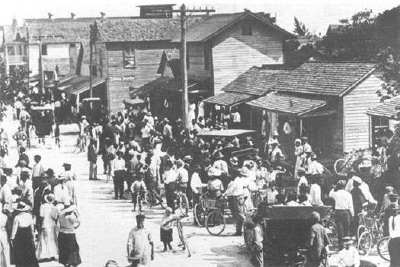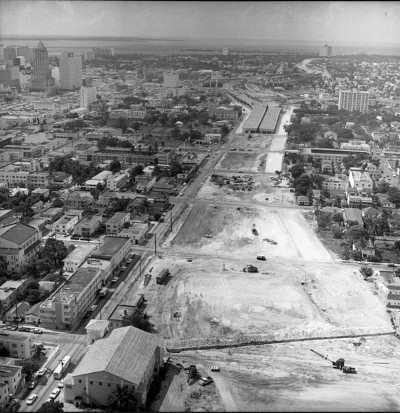
| dd |
A History of Overtown
Vibrant Early Life Followed by
Social and Physical Deterioration
Most Americans know Overtown only as the scene of some of the worst urban ghetto rioting since the 1960s. There have been disturbances three times in the 1980's (1982, 1984, and 1989) Television brought the riot into the living rooms of the American people with images of smoke and flame, random violence and killing with police confrontations with rampaging youths. Following the riots, there were numerous analyses that attempted to determine the underlying causes. Few of these attempted to trace the historical causes.

Overtown is located directly north of Downtown, is, after Coconut Grove, is the second oldest black community in Miami-Dade County. It owes its birth to railroad magnate Henry Flagler, who rolled into town, connecting South Florida to the rest of country. Many blacks, who provided labor to Flagler, headed to Miami. The city of Miami platted the land west of the railroad tracks, designating it a place where blacks could live. The segregationist laws of the times prevented these workers from living elsewhere as they migrated south to work on the railroads. They called it Colored Town and life flourished there.
During the 20's, 30's and 40's Overtown was Black Miami's showcase, centerpiece, and mecca: a self-sustaining community filled with an entertainment district, shops, groceries, law offices -- even a hospital. Although it could not compare with the affluence of white Miami, black businesses prospered as well as churches, social and civic associations.
The churches were -- and still are -- the center for civic and social life in the black community. Overtown was home to many of Miami's successful black families. William A. Chapman Sr., a prominent black physician, lived and worked there. His house at Northwest Third Avenue and 11th Street is now used by Miami-Dade County Public Schools as a research center. There's Dana Albert Dorsey, Miami's first black millionaire, who made his fortune buying land. A replica of his home was rebuilt several years ago at its original location at 250 NW Ninth St. by the Black Archives, History and Research Foundation, an organization that is pushing to revive the once-thriving entertainment district of Overtown. During its heyday -- during the 1920s, 30s, and 40s -- black musicians and artists hung out in Overtown after performances on then-segregated Miami Beach.
 Overtown continued its relative stability during the 1950s but things changed drastically during the 1960s. By 1965 much of Overtown had been razed for highway construction and "urban renewal." Interstate 95, a ten lane expressway which today is Miami's primary north-south artery, along with the East-West Dolphin Expressway (State route 836) were both constructed directly through the heart of Overtown during the 1960s. Later Metrorail, Miami's new billion dollar urban mass transit system, was routed directly through the community causing further dislocation.
Overtown continued its relative stability during the 1950s but things changed drastically during the 1960s. By 1965 much of Overtown had been razed for highway construction and "urban renewal." Interstate 95, a ten lane expressway which today is Miami's primary north-south artery, along with the East-West Dolphin Expressway (State route 836) were both constructed directly through the heart of Overtown during the 1960s. Later Metrorail, Miami's new billion dollar urban mass transit system, was routed directly through the community causing further dislocation.
These same forces that destroyed or altered the physical structures also weakened the social underpinnings of the community. Businesses folded, churches closed, and many residents were forced to leave. Overtown today characterized by vacant lots, high unemployment rates and over-crowded rundown housing. A few small businesses struggle among the abandoned and boarded up buildings.
Overtown is now one of Miami-Dade's poorest communities, buried beneath Interstate 95. These days, the majority of people who live there are those who have very few choices. Rent is cheap and public and subsidized housing is available. Many of the homes and businesses are gone, bulldozed when interstates 95 and 395 dissected the community.
Much of the present day overcrowding, rodent infestation, and dilapidation are directly caused by governmental policies of urban renewal and highway construction which have caused massive displacement (with little or no replacement housing) resulting in overcrowding of remaining units. Landlords have reaped significant profits from deteriorated properties without having to upgrade them.
There is a perception on the part of Overtown's residents that the city does not really want new low income housing in Overtown but instead would like to see the area "gentrified." Overtown is directly in the path of the northward march of Downtown Miami. A major commercial and residential development project called the Southeast Overtown/Parkwest Redevelopment Plan was planned in the 1980's for the southeastern corner of Overtown. The vast majority of the residential units were to be affordable only for renters earning a moderate income or above. As part of that project the Miami Arena was built to the specifications of the Miami Heat (who have now abandoned the facility for another publicly subsidized facility a few blocks to the east). Up until 1983 city and county officials did not vigorously enforced the housing code even though they were aware of numerous violations. Then, in a major shift in policy, the city began a massive code enforcement effort. The city made little efforts towards informing landlords of the availability of low interest renovation loans or in working with these landlords in facilitating renovation. The result was the displacement of hundreds of low income residents through the condemnation and destruction of low income apartments.
